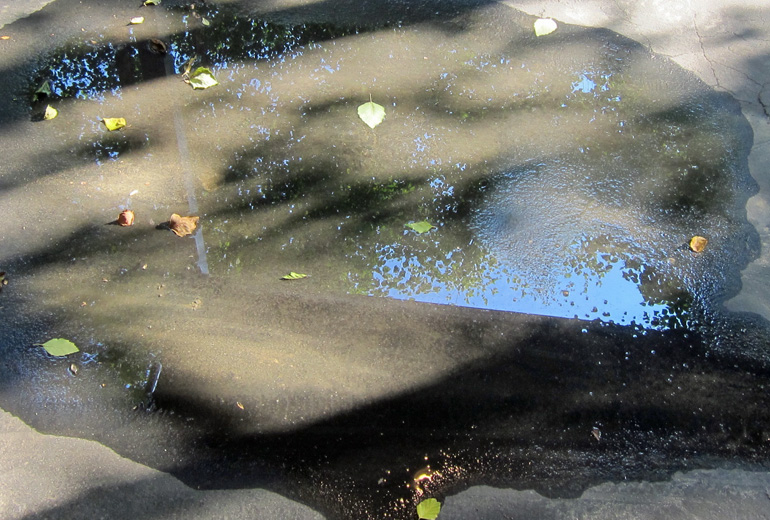Gotham Diary:
Thrust
22 July 2013
After an early dinner on Friday night, Kathleen and I watched two movies. The second feature was Hyde Park on Hudson, which I’d seen in the theatres but which was new to Kathleen. It’s a great picture, deftly combining two stories — the long-running affair that FDR had with his genteel but poor fifth cousin, Daisy Suckley, and the visit of George VI and Queen Elizabeth to the American president’s country house in 1939 (the first-ever royal visit to the United States) — with an extraordinary cast headed by Bill Murray and Laura Linney. (Mr Murray seems to have been born to play the trickster patroon.) It’s Olivia Williams, however, as Eleanor Roosevelt who catches my eye. With her relentless smile, touched up with condescension and impatience as if these were a new kind of face-powder, Williams brings home the way in which Eleanor was not only liberated by the collapse of her marriage but emboldened to transform it into a political partnership that gave her the broadest imaginable platform for heavy-duty consciousness-raising. They used to tell a marvelous story about Eleanor giving an address at the United Nations, back in the day when the visitor’s gallery was also a peanut gallery. Her subject was to sing the praises of Adlai Stevenson. “Adlai Stevenson headed the Democratic Party slate in Ninteen-Hundred-and-Fifty-Two, and he headed it again in Nineteen-Hundred-and-Fifty-Six…” At this point, some wiseacre called out, “Adlai Stevenson’s an ass!” To which Eleanor replied, ineffably, “Nevertheless…”
The first feature was The Swan, Charles Vidor’s adaptation of Molnár’s 1914 play. The Swan might well be considered Hollywood’s wedding present to Grace Kelly. Not only was it released on the day of her marriage to Prince Rainier of Monaco, but it recanted fifty years of American story-telling by sticking to the tenets of European aristocracy, according to which, at least in those days, princesses do not run off with tutors. The conceit of the story, that princesses are like swans, beautifully majestic on the water (set off and apart) but waddlingly awkward on dry land (mixing with hoi polloi), is not quite borne out by the leading lady, who was never ungainly anywhere, but her Alexandra does conclude that she has been “a goose” before asking her intended, the crown prince played by Alex Guinness with his patented, barely-suppressed lunacy, to take her hand. The velvet gloves of MGM are ever at the throat of this light romantic comedy, itching to suffocate it with spectacle, but the actors — Louis Jourdain, Jessie Royce Landis, Estelle Winwood, Brian Aherne, Agnes Moorehead, Robert Coote (and even Leo G Carroll as the major-domo) — keep the air sparkling and electric.
This would be Kelly’s penultimate movie. (Her last would be, just as aptly, High Society.) She would waltz off to Monaco and break Alfred Hitchcock’s heart. Watching her in The Swan, I truly understood Vertigo for the first time, seeing it completely as the story of a film director who loses his favorite star to a stellar marriage; in the movie that he makes about this disaster, she is replaced by a common woman who falls to her death twice. Kelly and Hitch remained the best of friends, but Vertigo tells us how he really felt.
The other movie that I couldn’t help thinking about was The Prince and the Showgirl, a misbegotten project with Molnárian overtones that wouldn’t be worth watching (except as a train wreck) if it weren’t for Simon Curtis’s wonderful My Week With Marilyn. After seeing the latter a couple of times, I had to see the movie that it was all about. Set at roughly the same time as The Swan, The Prince and the Showgirl features the same aristocrats but a different kind of commoner; instead of earnest and brooding Louis Jourdain, we get the bodice-popping Marilyn Monroe. As Grace Kelly whirled around the dance floor in Jourdain’s arms, I couldn’t help seeing her as the self-possessed beauty that Monroe never managed to be. Monroe, saturated in sexiness, was a tremendous comedian, but she could never be serious for more than two seconds. Hitchcock himself told François Truffaut why.
Sex on the screen should be suspenseful, I feel. If sex is too blatant or obvious, there’s no suspense. You know why I favor sophisticated blondes in my films? We’re after the drawing-room type, the real ladies, who become whores once they’re in the bedroom. Poor Marilyn Monroe had sex written all over her face, and Brigitte Bardot isn’t very subtle either.
Hitchcock goes on to say that he is more excited by Nordic ice goddesses: “Sex should not be advertised.” Truffaut begs to insist that this is a minority position. Hitchcock concedes the point without conceding anything.
That may well be true, but you yourself admit that those actresses generally make bad films. Do you know why? Because without the element of surprise the scenes become meaningless. There’s no possibility to discover sex. Look at the opening of To Catch a Thief. I deliberately photographed Grace Kelly ice-cold and I kept cutting to her profile, looking classical, beautiful, and very distant. And then, when Cary Grant accompanies her to the door of her hotel room, what does she do? She thrusts her lips right up to his mouth.
There is no thrusting in The Swan; it wouldn’t be much of a wedding present if there were. But I ask you: how did Hithcock, given his fascination with monuments and celebrity addresses, fail to make use of Biltmore, the Vanderbilt faux-chateau in North Carolina? Vidor certainly puts it to wonderful use in The Swan.

